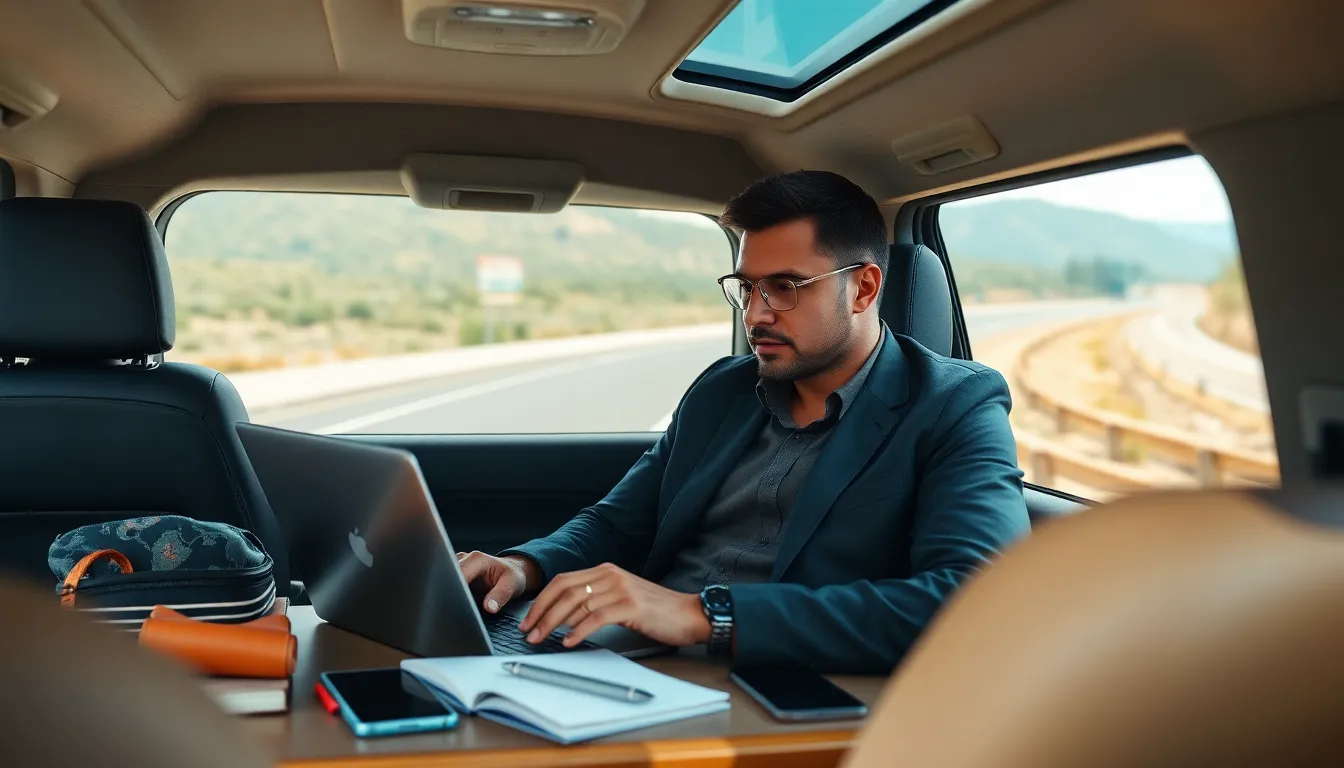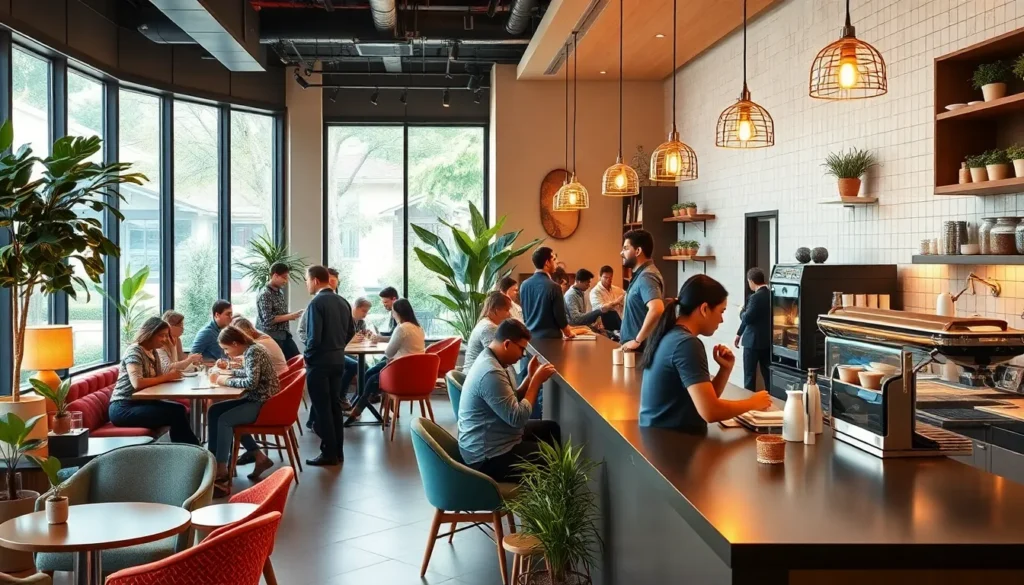In today’s fast-paced world, staying productive while on the road can feel like a daunting challenge. Whether it’s for business travel or a long-awaited vacation, finding ways to maximize time and efficiency is crucial. With the right strategies, anyone can turn travel time into valuable opportunities for work and personal growth.
Traveling often means limited access to traditional office setups, but that doesn’t have to hinder productivity. Embracing technology and smart planning can transform how tasks are approached on the go. From utilizing mobile apps to optimizing schedules, there’s a wealth of resources available to help maintain focus and drive results, no matter the location.
Table of Contents
ToggleUnderstanding Productivity on the Road
Productivity on the road refers to the ability to work efficiently while traveling. Implementing effective strategies enhances both personal and professional growth during trips.
Definition and Importance
Productivity on the road encompasses any effective work completed while away from a traditional office. It includes tasks like responding to emails, attending virtual meetings, or planning projects. Its importance lies in maximizing valuable time away from one’s usual environment, turning travel into an opportunity. Employees or stakeholders who maintain productivity during travel contribute to their organization’s success and foster work-life balance amid busy schedules.
Challenges Faced While Traveling
Travelers encounter several challenges that can hinder productivity.
- Time Constraints: Limited hours for work due to travel schedules can reduce available work time.
- Distractions: Unexpected interruptions from travel activities or social settings can disrupt focus.
- Inadequate Resources: Limited access to office tools and stable internet connections can impede efficiency.
- Fatigue: Long travel hours often lead to physical and mental fatigue, diminishing productivity.
- Changing Environments: Adapting to new surroundings and routines can cause disruptions to established workflows.
Addressing these challenges with strategic planning enhances productivity outcomes on the road.
Strategies for Enhancing Productivity

Implementing effective strategies increases productivity while traveling. Focus on specific techniques and tools that streamline tasks and enhance efficiency on the road.
Time Management Techniques
- Prioritize Tasks: Identify high-impact tasks and focus on completing those first. Use frameworks like the Eisenhower Matrix to distinguish between urgent and important activities.
- Set Time Blocks: Allocate specific time slots for tasks. Designate uninterrupted periods for work to maximize focus and minimize distractions.
- Utilize Breaks Wisely: Incorporate short breaks to recharge. Use these intervals to reflect on progress and plan the next steps.
- Establish Daily Goals: Set clear, achievable objectives for each travel day. Break larger projects into smaller tasks to track progress and maintain motivation.
- Plan Ahead: Organize the travel schedule before the trip. Map out meeting times, work periods, and leisure activities to ensure a balanced approach to productivity.
Tools and Apps for Road Productivity
- Task Management Apps: Tools like Todoist and Asana help organize tasks and track deadlines. These apps provide lists and reminders, keeping productivity on track.
- Note-Taking Software: Utilize apps such as Evernote or OneNote to capture ideas and important information. Syncing across devices ensures access from anywhere.
- Time Tracking Tools: Apps like Toggl and Harvest facilitate tracking hours spent on tasks. This analysis produces insights on productivity patterns and helps adjust efforts as needed.
- Communication Platforms: Leverage tools like Slack and Zoom for seamless communication. These platforms allow for quick exchanges and virtual meetings, reducing response times.
- Cloud Storage Solutions: Using Google Drive or Dropbox ensures access to files while traveling. These services facilitate collaboration and secure document sharing with team members.
Creating a Productive Environment
Creating a productive environment while on the road significantly enhances one’s ability to work effectively. With the right setup and strategies, individuals can overcome typical travel challenges and maintain focus.
Setting Up Your Workspace
Establishing a dedicated workspace promotes productivity. Choose a quiet spot in a hotel room, airport lounge, or café. Ensure adequate lighting and a comfortable seating arrangement. Use a portable desk or a lap desk to create a defined workspace. Keep essential tools like a laptop, chargers, and notepads organized within reach. A clutter-free environment fosters concentration and efficiency.
Minimizing Distractions
Minimizing distractions is crucial for maintaining focus on the road. Use noise-canceling headphones to block out ambient noise, particularly in busy locations. Activate the “Do Not Disturb” mode on devices to reduce interruptions from notifications. Schedule focused work sessions during quieter times, such as early mornings or late evenings. Limit personal phone use during these blocks, aiming to prioritize professional tasks. Establishing a routine helps signal the mind that it’s time to work, regardless of the physical environment.
Balancing Work and Travel
Balancing work and travel requires strategic planning and realistic expectations. Implementing effective methods helps maintain productivity while enjoying the journey.
Setting Realistic Goals
Setting realistic goals is essential for effective productivity on the road. He or she should determine achievable daily objectives that align with travel schedules. These objectives must be specific, measurable, and time-bound to enhance focus. For example, a goal could be responding to ten emails or completing a project outline by a certain time. It’s vital to plan for interruptions, allowing flexibility for unexpected changes in itinerary. By breaking larger projects into smaller tasks, they can maintain momentum without feeling overwhelmed.
Prioritizing Tasks on the Go
Prioritizing tasks on the go ensures essential responsibilities receive attention first. They can utilize frameworks like the Eisenhower Matrix to categorize tasks by urgency and importance. High-priority tasks should be completed during peak energy times, often in the morning or after short breaks. For instance, handling critical emails or making key decisions early in the day can prevent procrastination. Additionally, creating a to-do list with identified priorities provides a clear path for the day. This method not only increases efficiency but also fosters a sense of accomplishment as tasks are completed.
Traveling doesn’t have to mean sacrificing productivity. With the right strategies in place, individuals can transform their journeys into opportunities for growth and accomplishment. By leveraging technology and smart planning, they can tackle tasks efficiently and maintain focus, regardless of their surroundings.
Creating a supportive work environment and establishing a routine are key components in achieving success on the road. Prioritizing tasks and setting realistic goals ensures that productivity remains high, even amidst the distractions of travel. Embracing these techniques can lead to not only enhanced work performance but also a more fulfilling travel experience.









